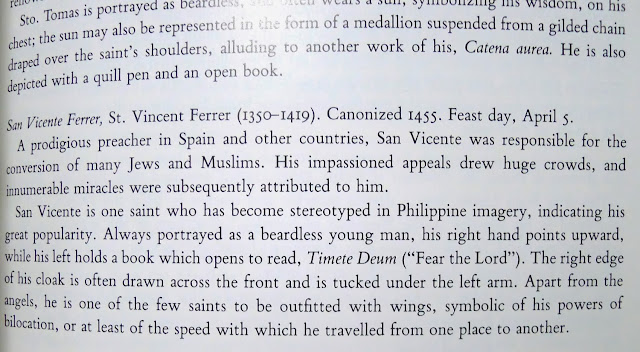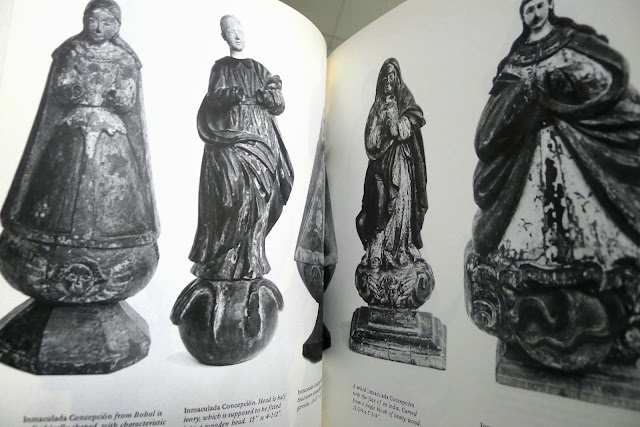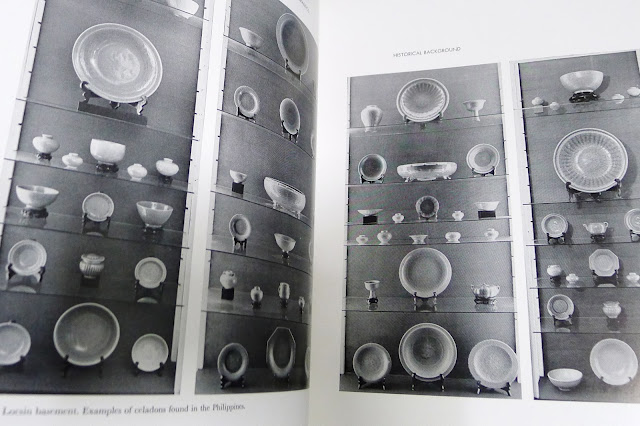Local Tales of Antiquarian Acquisition, De-accession, and Salivation.
Wednesday, 25 December 2013
Book 03: Images of Faith
I ordered this via Amazon on a lark since it was reasonably priced at $4.50. It turned out to be one of the best written catalogs concerning the history, trade of ivory in the Philippines and its uses as ecclesiastical artifacts.
Images of Faith was published by the Pacific Asia Museum last 1990. Though simple in design, the articles written by Regalado Trota Jose is so rich and precise that one could mine a lot of information from it. From the sources of the ivory, the reason why most of the pieces can be found outside the Philippines, the Chinese features in the sculptures to the last ateliers of the previous century, Mr. Jose elaborated on such interesting aspects that after reading his paper, one would have gained an encompassing sense of knowledge on the subject.
The author also gave lots of time on the identification on the different saint types from the different manifestations of the Virgin, to the positions of the Baby Jesus to the different saints of the Holy orders. He made sure to include each attribute so to help ease in the identification of a particular saint. Such meticulousness in his descriptions without deteriorating into pedantry is really really commendable. Actually, after going over his research, you might not care anymore about the pictures.
So is it worth getting if you're into santo collecting? Yes!
Saturday, 21 December 2013
Book 02: A Heritage of Saints
I simply love Esperanza B. Gatbonton's A Heritage of Saints: Colonial santos in the Philippines. It's richly textured without sounding like a dissertation paper. And her collector's passion in her words is tempered by the need to elaborate and organize the different saints and relics that abound in the Philippines. This was published during the heyday of the 70s wherein religious antiques of great quality still can be found in the shops along Mabini and del Pilar. So, it is safe to say that this book is a product of the madness of antiquing during this period. Now, you would be consider lucky if you can find cheap yet authentic ivory pieces in the shops.
The book first delves into the history of the Filipino santos and the cult that it has spawned. From the conversion of the native heathens to Catholicism to the refashioning of the idols into household saints, it proves that our form of Christianity is still a part of our precolonial temperament. She also talks about the art and craftsmanship of the santero or saint-maker and also the specific saint types like San Roque (St. Roche) to San Vicente (St. Vincent). Her writing is vivid yet rich with details. More importantly, the pictures are there to remind you that your santos in the sala may or may not be the real thing. And those in the photos are those pieces that may have gotten away.
Books (unlike catalogs) specifically on antique santoses/saints are
really scant and rare. So far I have two out of the three better known works devoted to Philippine santos thanks mainly to the convenience of the web. I am still searching for a reasonably priced Fernando Zobel de Ayala's Philippine Religious Imagery (Ateneo de Manila Univ., 1963). A diligent search in the net is a must if you're truly passionate in collecting antiques. Not just for the objects but the books that delve into the subject. And Mrs. Gatbonton's book is a treasure indeed. And procuring one in near-mint condition is joyous indeed.
Book 01: Oriental Ceramics Discovered in the Philippines
If there’s a book that every Filipino ceramic collector should have in his/her library, this is the one. This is one of the earliest and most cited work when it comes to ceramics and Philippine terrestrial archaeology.
Written during the plentiful year of the 60s by famed
artist-archaeologist Leandro Locsin, Oriental Ceramics traces the origins of
the trade, the history and the variety that they unearthed in Sta. Ana and
Calatagan. Aided by Robert Fox and the
National Museum, Locsin has managed to systematically study and catalog early
trade ceramics in a way that gives us a clear glimpse of the richness of precolonial Philippine
society.
Presently, there has not been a book of this magnitude and scale ever published. Even the famed author on Asian ceramics, Roxanna Brown, acknowledged in her book The Ming Gap and Shipwreck Ceramics in Southeast Asia (The Siam Society, 2009) that the Sta. Ana and Calatagan finds were important because they constitute large burial finds that do not have a single Chinese blue&white ceramic.
Published by Tuttle in Japan in 1967, Oriental Ceramics has the marks of being a collector's book. Hardbound in a blue buckram cover with gilded lettering, the volume is worth the $22.50 retail price. The paper used was heavy glossy paper similar to those mid-century US encylopedias we have in the house. There are 228 plates and 89 in full color. Color printing back then must have commanded a premium price. The photos are crisp and well lighted. For collectors, the pieces featured inside are great reference to cross-check any collection. Mostly, the pieces are Thai, Vietnamese or southern Chinese. If you're looking for Ming, you might want to check another book.
Famed historian Ambeth Ocampo collected and sold this volume. He recounted in the September 2006 newsletter of the Oriental Ceramic Society of the Philippines:
" I was so disinterested in ceramics that I sold two copies of the rare book, Oriental Ceramics Discovered in the Philippines by Leandro and Cecila Locsin. When I got hold of a third and fourth copy in 1999 and actually leafed through them, I realized very late that any study of Philippine pre-history inevitably touched on ceramics. These were so important that the pioneering pre-historian H. Otley Beyer even wrote an article on ‘The Philippines in the Porcelain Age’ (roughly the 9th to the 16th centuries). ... The more I read, the more interested I became and when I went into antique shops, I would give ceramics a second look and realize that they were objets d’art and not just traces of our history."
This is why if you are absolutely serious about collecting antique ceramics in the Philippines, then try to procure this book.
Published by Tuttle in Japan in 1967, Oriental Ceramics has the marks of being a collector's book. Hardbound in a blue buckram cover with gilded lettering, the volume is worth the $22.50 retail price. The paper used was heavy glossy paper similar to those mid-century US encylopedias we have in the house. There are 228 plates and 89 in full color. Color printing back then must have commanded a premium price. The photos are crisp and well lighted. For collectors, the pieces featured inside are great reference to cross-check any collection. Mostly, the pieces are Thai, Vietnamese or southern Chinese. If you're looking for Ming, you might want to check another book.
Famed historian Ambeth Ocampo collected and sold this volume. He recounted in the September 2006 newsletter of the Oriental Ceramic Society of the Philippines:
" I was so disinterested in ceramics that I sold two copies of the rare book, Oriental Ceramics Discovered in the Philippines by Leandro and Cecila Locsin. When I got hold of a third and fourth copy in 1999 and actually leafed through them, I realized very late that any study of Philippine pre-history inevitably touched on ceramics. These were so important that the pioneering pre-historian H. Otley Beyer even wrote an article on ‘The Philippines in the Porcelain Age’ (roughly the 9th to the 16th centuries). ... The more I read, the more interested I became and when I went into antique shops, I would give ceramics a second look and realize that they were objets d’art and not just traces of our history."
This is why if you are absolutely serious about collecting antique ceramics in the Philippines, then try to procure this book.
Subscribe to:
Comments (Atom)











